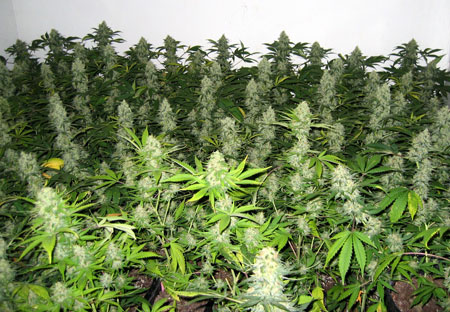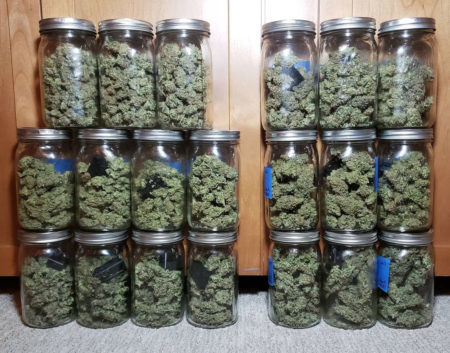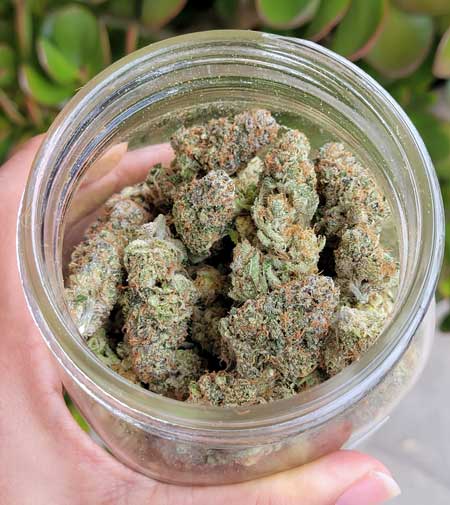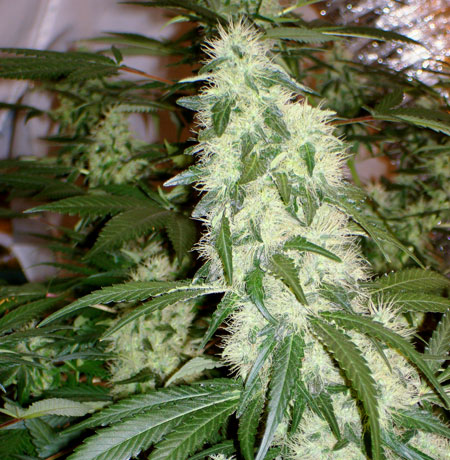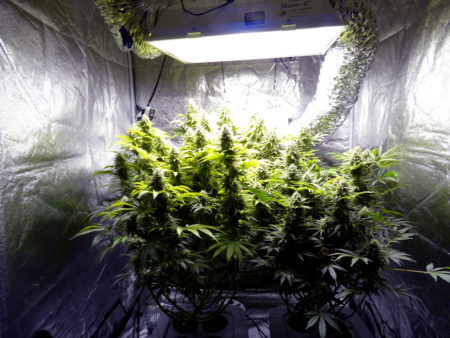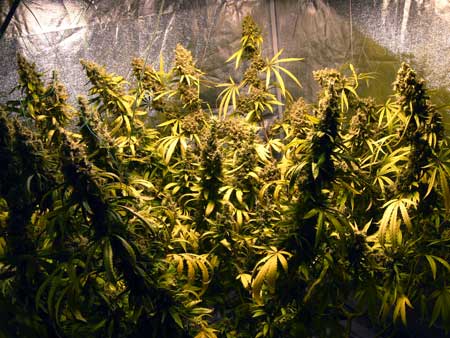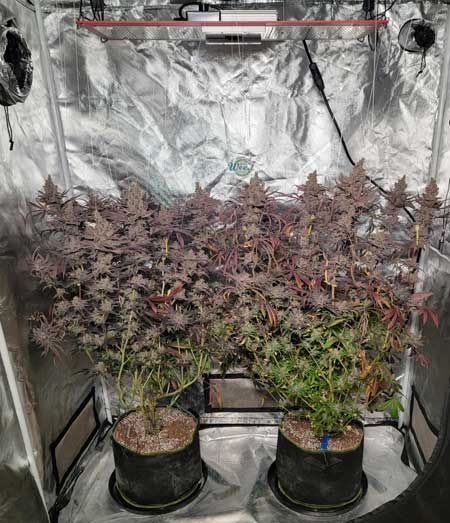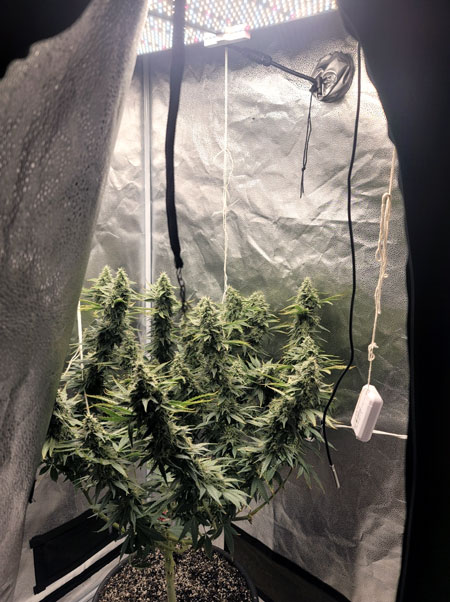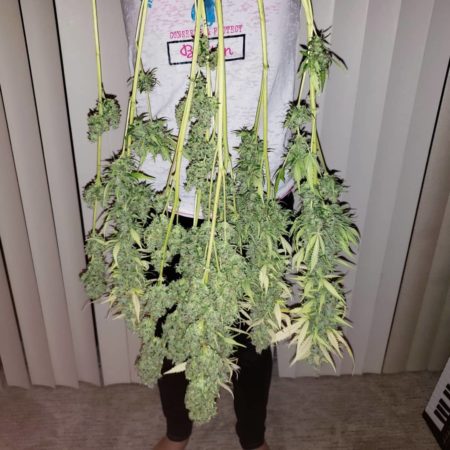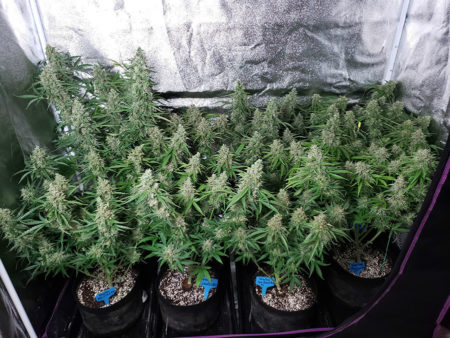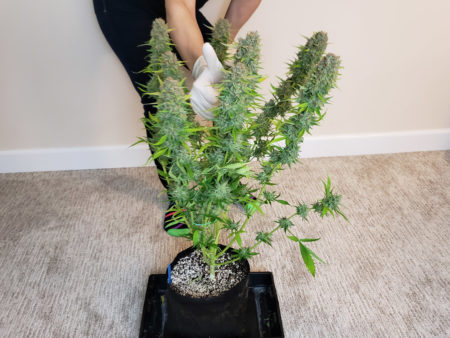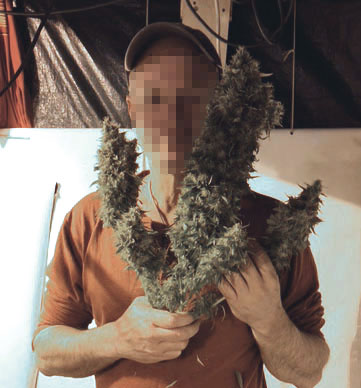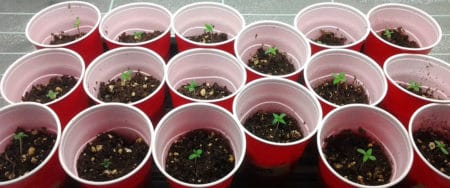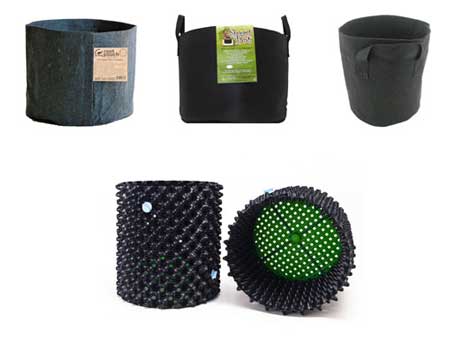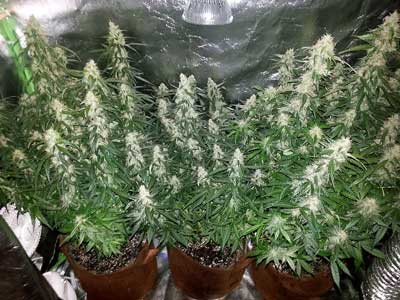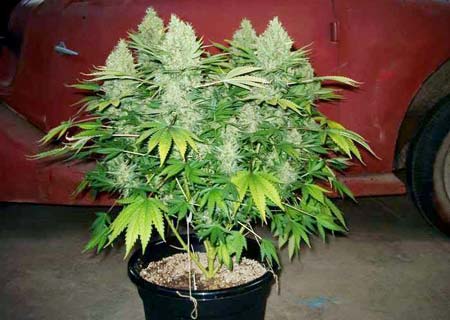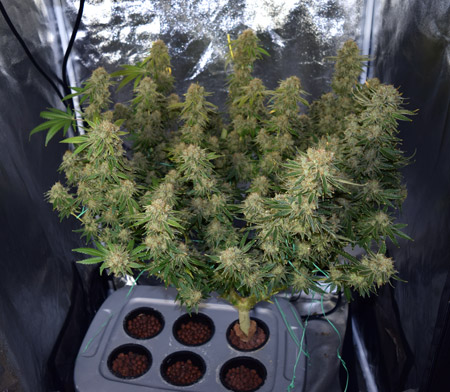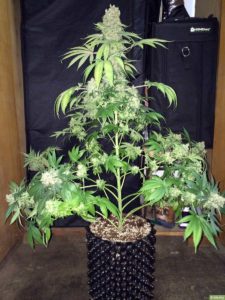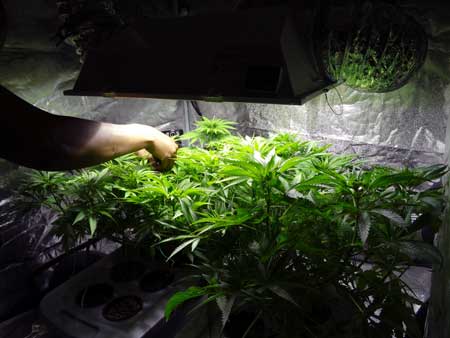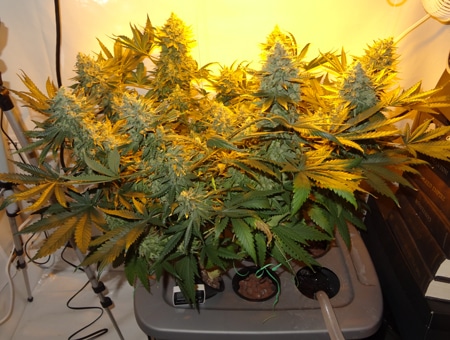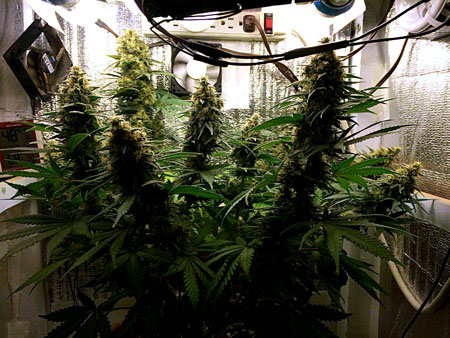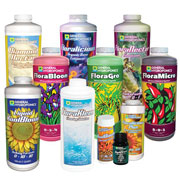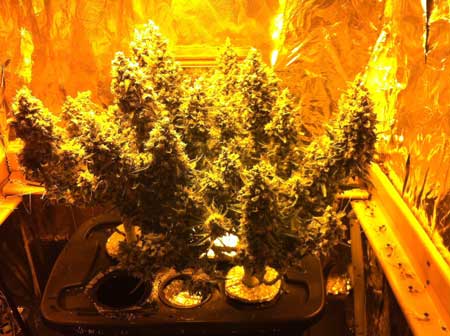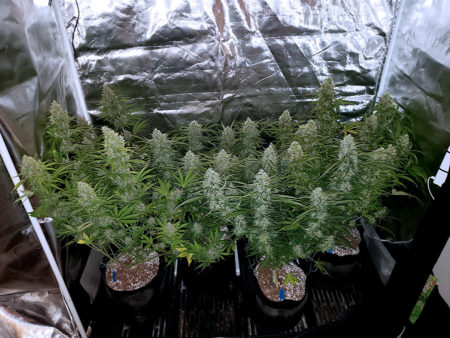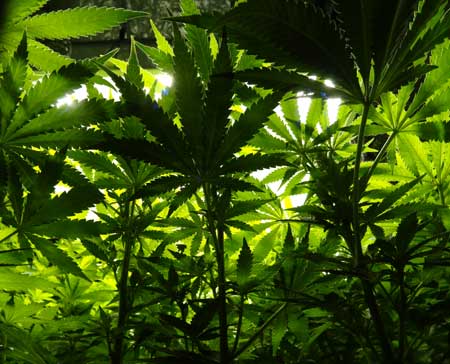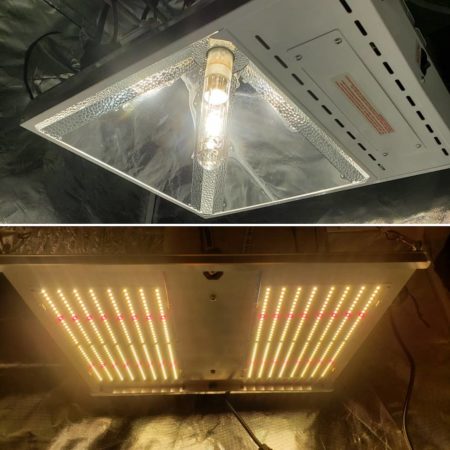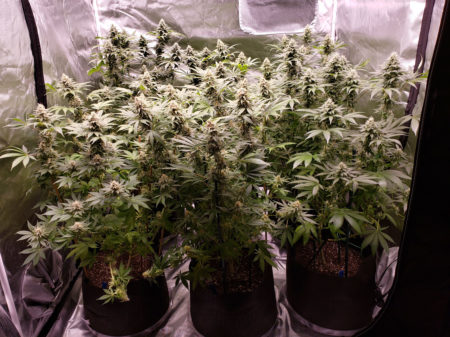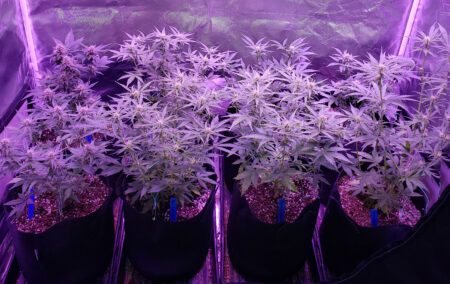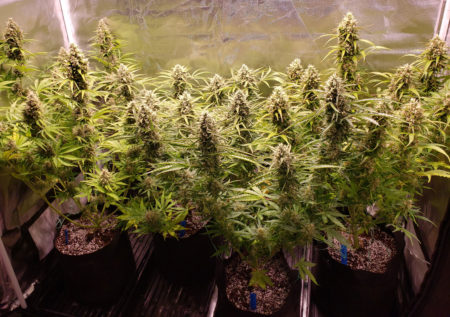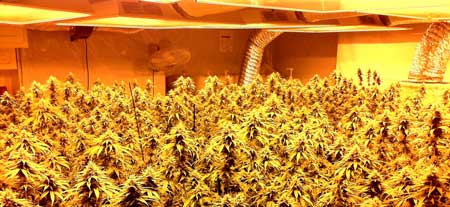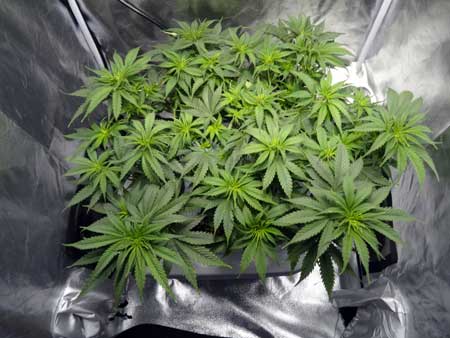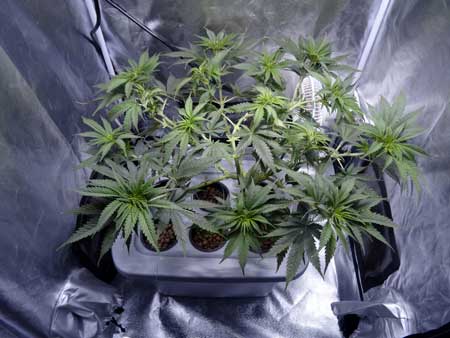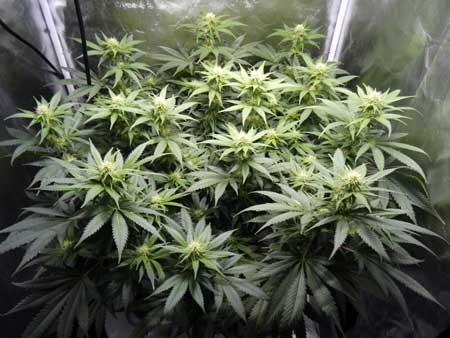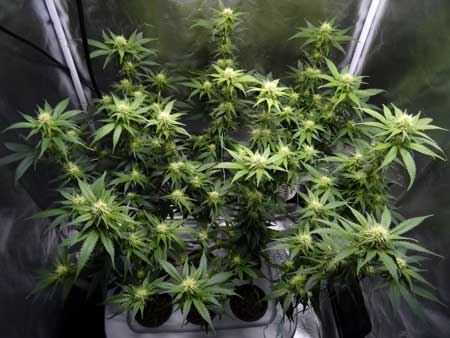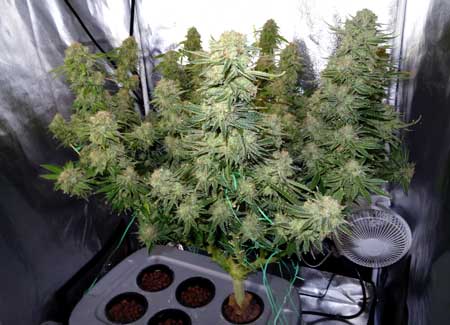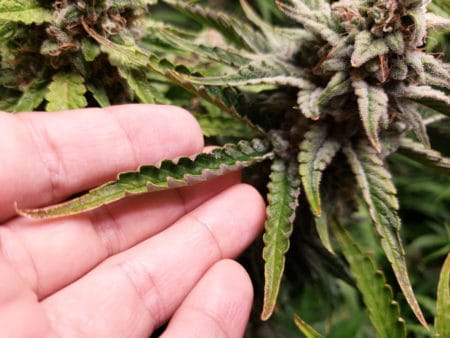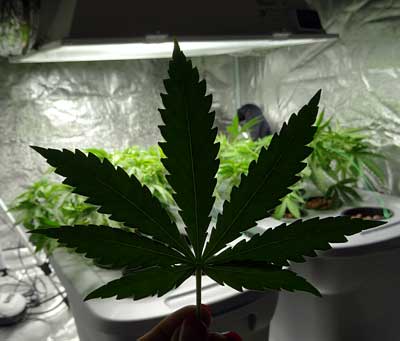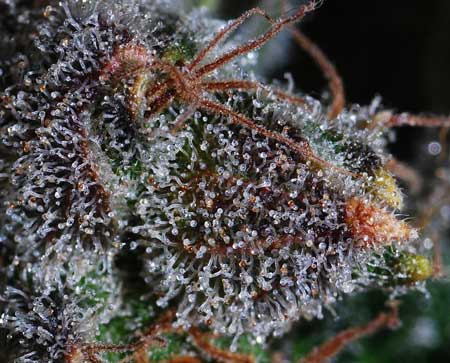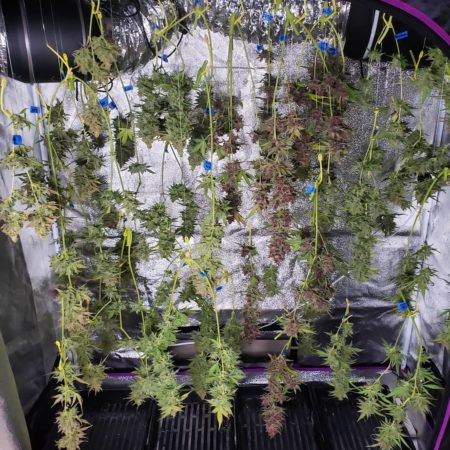by Nebula Haze
A lot of indoor cannabis growers struggle with yields. It’s fantastic to grow your weed, but you must grow enough that you never run out. Otherwise, growing may feel like a waste of time and effort.
Luckily, cannabis yields don’t have to be a mystery. There are specific factors that cause yields to be big or small, and nearly all of them are under your control. The following article contains a comprehensive list of what you can do (both before and after buds start forming) to increase yields.
Learn how to achieve bigger yields in less time with less effort
Table of Contents
Before Buds Start Forming
- Choose High-Yielding Genetics – Strain choice has a significant effect on yields, so it helps to choose a strain that naturally makes big buds. Learn what to look for, and get a list of recommended strains that produce fat, envy-worthy buds.
- Grow Correct Number of Plants – Match the number of plants to your space and grow light. Often you’ll get bigger yields/faster harvests with many smaller plants as opposed to a few big ones.
- Use The Right Plant Containers – Choose the right container type and size for your setup, so plants grow as fast and big as possible.
- Use Coco or Hydro – Soil-grown plants typically grow slower than plants grown in coco or hydroponics. If you want to maximize the number of harvests each year, you should aim for fast-growing plants.
- Manipulate How Plants Grow – Plant training in the vegetative stage is an effective and free way to increase yields dramatically.
- Choose Good Nutrients and Supplements – Get cannabis-specific nutrients, and remember that sometimes less is more.
- Grow Plants to Most Efficient Size – Too-big plants can cause considerable problems, but plants that are too small don’t have the structure to support big buds. Maximize yields by growing plants to the right size for your space.
After Buds Start Forming
- Increase Light Intensity – Light is food to your plant, and giving more light will increase yields (to a point).
- Use Suitable Flowering Lights – For the best yields, you should be using LEDs (best choice for most growers), LEC/CMH, or HPS grow lights while buds are forming. Avoid “blurple” LEDs or fluorescent grow lights.
- Give Best Light Spectrum While Buds Form – Giving plants more red and far-red light in the flowering stage seems to increase yields compared to using the same grow light in a bluer spectrum. Learn which bulbs/lights work best below.
- Follow a Recommended Defoliation Schedule – Remove specific leaves at specific points of bud development to “hack” the plant’s natural processes and cause buds to grow bigger and denser than they otherwise would.
- Don’t Ignore Problems! Plants get much more picky about nutrient ratios and nutrient strength in the flowering stage, especially as harvest approaches. Make sure you quickly diagnose and fix any nutrient deficiencies, bug infestations, or other visible problems. An unhealthy plant doesn’t have as much energy to put into bud formation.
- Create an Optimum Bud-Building Environment – Hot or humid air with poor air circulation in the flowering stage causes buds to grow more airy and loose (among other problems). Reflective walls can help you get the most from your lights, and some growers supplement their environment with CO2 to increase yields.
- Harvest Plants at the Right Time – Especially don’t harvest early.
And Most Importantly…
- Always Be Growing – If you don’t pause between harvests, your bud coffers will soon be overflowing. Along the same lines, never stop learning!
Grow a lot of buds so you never run out
Bonus: Many of these techniques also increase THC levels, bud density, and overall bud quality.
There are a few ways to think about increasing cannabis yields indoors. Some growers want to maximize the yields for their grow space, and don’t care what it takes to increase yields overall. Other growers are looking at returns from more of an economic perspective, wanting to get the best yields for the electricity/cost, but maybe aren’t as concerned with how much space it takes. Lastly, there are many growers just looking to grow huge impressive buds and don’t care about maximizing anything else. This article is going to talk about all three. No matter what you’re looking for, we’ve got you covered.
Without further delay, it’s time to learn how to increase your yields!
You know a bud is going to get huge if it’s already fat before the white hairs start darkening and curling in!
Before Buds Start Forming
These are the actions you can take to prepare for a fruitful flowering stage.
1.) Choose High-Yielding Genetics
A lot of growers focus purely on their setup, nutrients, growing technique, and other aspects of their environment, yet don’t pay much attention to strain.
Your genetics have a tremendous effect on yields. If you grow two plants in the same conditions, chances are one will produce more bud than the other. Sometimes the yield differences between strains are enormous. Bonus reason to care about genetics: They determine the effects the buds will have as well as the amount of THC/CBD produced (within a few percentage points). Make sure you start with good seeds!
Even though both of these plants were grown in the same setup and given the same care, the left plant (Liberty Haze) yielded 10 ounces, while the right plant (L.A. Confidential) yielded only 6 ounces.
To confuse things further, different strains perform best under different grow lights, grow setups, and grow mediums.
Here are some resources to get you started choosing the best strain:
- Which Cannabis Breeders Can I Trust?
- How to Find a Strain That Does What You Want
- How to Grow Different Strains Together
And here are some suggested high-yielding strains that produce high-quality buds with excellent effects. Everyone will be asking for more, and you’ll have it!
Recommended Photoperiod (Standard) Strains
Most cannabis plants are photoperiod strains. Here are some of the highest-yielding strains we’ve grown:
- White Widow – Enormous yields every time. A commercial producer with excellent buds and potency.
- Platinum Cookies – In addition to excellent yields, the bud quality is out of this world. The beautiful purple buds tested at over 25% and almost 27% THC respectively when we sent buds to the lab. In smoke tests, the effects were a crowd favorite. This strain tends to get tall, but it can thrive in any setup if you use bending and supercropping to keep it short and flat. It has a longer flowering stage than average (about 12 weeks from initiating 12/12 light schedule vs about 10 weeks average for most strains). But the rewards are worth 2 extra weeks in my opinion.
- Chocolope – This strain is easy to grow and produces big buds which produce strong “creative” mental effects. The smell has delightful hints of chocolate; a unique smell in the cannabis world.
The White Widow strain produced epic yields under a 600W HPS grow light. It also performs great under LED grow lights.
The Platinum Cookies strain rewards you with potent buds (the lab reported 25% THC from one plant and 27% THC from the other) and huge yields. Read my full Platinum Cookies review for more information and pictures of the plants. This was grown under a 300W LED grow light (check out the full 300W LED setup so you can copy these results).
This Chocolope cannabis plant was grown under a Spider Farmer SF-2000 200W LED grow light (read my review of the SF-2000) and the buds got huge.
Recommended Auto-Flowering Strains
Autoflowering strains have come a long way. Some modern autoflowering plants produce similar yields and bud quality to photoperiod plants, yet are ready to harvest about a month sooner on average. That means you can fit more harvests in a year without sacrificing yields per harvest. More harvests = more buds for you!
- Big Bomb Auto by Bomb Seeds – Each autoflowering plant I’ve grown from Bomb Seeds has performed well in multiple environments (soil, coco, hydro, LECs, various LEDs, HPS). Buds are always potent and sticky, and Big Bomb has the best yields of their autoflowering selection. An all-around winner! Another great choice from Bomb Seeds is their THC Bomb Auto. It has slightly smaller yields but sparklier buds.
- Ultimate Auto by Dutch Passion – Classic 90s mental and physical effects, easy to grow, impressive yields every time. Their Cinderella Jack Auto also gets excellent yields and has much more potent bud effects (may be too potent for some people).
- Pineapple Express Auto by FastBuds – Another plant that always performs well no matter how you grow it. Stays short, easy to train, and all-around a joy to grow. For those who want the classic sweet-smelling delicious strain in auto-flowering form. Faster to harvest than most autos as it can be ready as little as 60 days from germination, though you should give it an extra week or two to really pack on the weight and maximize the smell and THC levels.
Example of a THC Bomb auto plant at harvest (Big Bomb Auto produces even bigger yields!)
The plant in the back left is an Ultimate Auto by Dutch Passion. It produced twice as much as any other plant in the tent.
Cinderella Jack Auto is another high-yielding auto-flowering strain by Dutch Passion. Plants tend to stay shorter than the Ultimate Auto so the yields aren’t quite as good, but it makes excellent dense buds with some of the highest potency I’ve grown from an auto-flowering strain.
Get huge buds with Pineapple Express Auto by FastBuds (stays short and quick to harvest, too!). This was a single plant grown by our friend Smarty! Look at that enormous main bud.
2.) Grow the Correct Number of Plants
The number of plants can affect your total yield in two ways:
- More Plants – Growing a lot of small plants lets you fill a grow space faster, resulting in more harvests in a year if everything else is the same. If you increase the number of harvests, you’ll produce more buds in the same amount of time. This idea is the basis of the Sea of Green method.
- Fewer Plants – You can achieve the same yields with fewer plants by letting them get big enough to fill a space, but it takes longer in the vegetative stage for plants to get to the final size. Depending on how much extra time, this can push back harvest time and reduce the total number of harvests you can produce in your grow space. If you must limit the number of plants (many growers have legal plant limits), you can maximize yields with training techniques such as manifolding.
What’s the Best Number of Cannabis Plants for my Space?
3.) Use The Right Pots
Choose the right container type and size for your setup.
- Air pots and fabric pots allow air to get to roots from the sides, resulting in significantly faster growth rates. The one downside is these pots need to be watered about twice as often because they dry out more quickly.
- Pots that are too big for your plant tend to slow growth, especially young plants that get overwatered. Learn how to water a small plant in a big pot so it grows as fast as possible.
- Too-small pots restrict plant roots and keep plants from growing as big as they could. Plants in big pots can get huge!
- If possible, it helps to start plants in a smaller container and transplant them to bigger ones after they’ve started growing vigorously. Learn more about transplanting.
Plants typically grow faster in containers that let air in from the sides (such as air pots and fabric pots)
What’s the optimal size for your final plant container?
A general guide is to have around 2 gallons per 12″ of the final desired height. Big plants often need a bit more. The following chart isn’t perfect since plants often grow differently, and some plants are short and wide instead of tall, but this is a good rule of thumb. If your final (desired) plant size is…
- 12″ ~ 2-3 gallon container
- 24″ ~ 3-6 gallon container
- 36″ ~ 5-8 gallon container
- 48″ ~ 7-10 gallon container
- 60″ ~ 8-15+ gallon container
Go bigger if you plan to spend time away from your plants! Bigger root space gives you more of a buffer if plants need to be unattended for days at a time.
These plants love their 5-gallon fabric pots!
4.) Use Coco or Hydro
Soil-grown plants typically grow slower than plants grown in coco or hydroponics because their roots have to work to pull the nutrients from the soil (as opposed to getting easily-absorbed nutrients delivered directly in the water). If you want to maximize the number of harvests each year, you should aim for the fastest-growing plants you can. More harvests mean more buds for you!
Plants grow quick and easy in coco coir. Coco is one of my favorite ways to grow!
It’s possible to get high-speed growth in soil, but it takes extra skill and care. I love how, in coco or hydro, your plants almost always grow fast as long as you keep plants healthy.
As long as you avoid root rot, plants in hydro typically grow faster than in any other grow medium
Hydro can be a bit tricky to get started with, but coco may be the easiest cannabis grow medium to use. I highly recommend first-time growers start with coco if they’re not drawn to any particular grow medium. You almost can’t kill your plants in coco as long as you remember to water them 🙂
Learn More About Soil vs. Coco vs. Hydroponics.
5.) Manipulate How Plants Grow
Plant training in the vegetative stage is an effective and free way to increase yields. But how does it work?
Without training, cannabis plants typically grow in a Christmas tree shape with one central bud
While your plants are still in the vegetative stage, train them to become wide and flat
Each growing tip at the top of the plant will turn into a big bud in the flowering stage
With more total buds, trained plants typically yield significantly more than untrained plants
Read the Complete Guide to Cannabis Plant Training and increase your yields for free!
6.) Choose Good Nutrients and Supplements
You’ll get the best results if you choose cannabis-specific nutrients. Most importantly, make sure to give low amounts of Nitrogen and plenty of Phosphorus and Potassium once plants start making buds. Luckily, most nutrients come with a schedule, so it’s simple to provide the right nutrients at the right time. If you get a good brand and look at their schedule, you won’t have to worry about nutrient ratios at all.
How can I grow cannabis without added nutrients?
When it comes to nutrients, sometimes less is more! It’s easy to go overboard, especially with certain strains. In general, it’s a good idea to start any new nutrients at half-strength and only increase the concentration if plants look pale.
Get cannabis-specific nutrients and follow their schedule at half-strength for the best results
If you give the right nutrients at the right time, plants explode with growth!
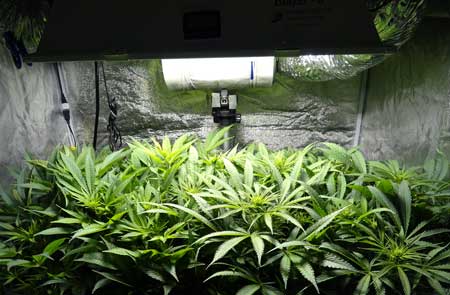
7.) Grow Plants to Most Efficient Size
It causes issues when plants are too big or too small. You can maximize yields by growing plants to the right size.
- Too-big plants cause significant problems – Plants can grow into the light, and you may not have any room to raise it further. When buds are too close to a grow light, they can get bleached and grow airy with foxtails. The lack of density in your top nugs can hurt your overall yields. If plants are too tall, it also means you likely spent unnecessary extra time in the vegetative stage or didn’t train plants to grow flat and wide. Learn how to deal with plants that grew too big.
- Too-small plants have small yields – When a plant is too small for a specific space, it won’t have the structure to support huge buds.
These plants have almost hit the ceiling and they’re still getting taller! The grower waited a little too long to initiate 12/12.
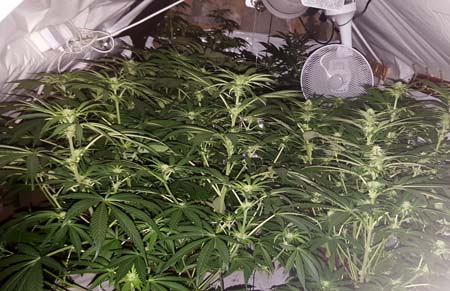
The following plant had several extra feet of height the grower could have used. If the grower gave this plant a few more weeks to get bigger in the vegetative stage, before switching to flowering, the plant would have produced significantly more bud without changing anything else.
This Aurora Indica plant had huge buds, but the total yield was just 3 ounces because the buds were only a few inches long. This grower would have gotten bigger yields if they let the plant grow a little bigger before initiating 12/12 so the buds could be longer.
How to grow photoperiod plants as big as your space can support, without letting them get too big:
- On average, cannabis plants double in size after the switch to a 12/12 light schedule
- Therefore, it’s a good rule of thumb to change to a 12/12 light schedule when vegetative plants reach half the final desired size
Learn more about the flowering stretch and how to prepare for it.
Note: Pay attention to what the breeder says about height to better estimate how much your plant will stretch. “Short” plants typically gain 1.5x their size, “Medium” plants double in size, and “Tall” plants grow to 3x their size. Don’t hesitate to contact the breeder with questions. Most breeders will happily any questions about their genetics.
You can use plant training to help control plant size, but only to a certain extent. Training and bending can’t keep plants small forever!
Autoflowering strains tend to stay small, so they may be an excellent choice if height is an issue!
After Buds Start Forming
Ok, your plants are already making buds. What can you do to increase yields at this point?
1.) Increase Light Intensity
To your cannabis plants: Light = Food = Energy. That means that your plants can produce bigger buds if they get more light (up to a point, you can go overboard!).
3 Main Ways to Increase Light intensity
- Get a bigger or better grow light (more info about which one to get in a second)
- Keep your grow light as close as possible without light-stressing plants
- Train plants to grow flat like a table under the light. Plant training allows you to keep the grow light closer without burning the tallest buds.
2.) Use Suitable Lights in the Flowering Stage
For the best yields, density, and bud size, you should be using one of the following grow lights while buds are forming:
- LED grow lights ← Best choice for most growers because they produce great yields, bring out bud colors, tend to stay cool, and have low electricity use. High-quality LEDs are incredible, but make sure to avoid low-quality LEDs as they get poor yields and tend to grow plants with a lot of nutrient deficiencies.
- LEC/CMH grow lights ← Best choice for high terpenes and trichome production, but produces significantly more heat per watt than LEDs so they’re best suited to cool grow spaces and winter grows.
- HPS grow light ← Best for cold spaces because they get hot. Cheapest grow light that can produce over a pound (a 600W HPS can yield up to 21 ounces and costs only $170; way cheaper than LEDs that get comparable yields).
Two phenomenal flowering grow light options: 315 LEC (top) and a 300W LED grow light.
3.) Give The Right Light Spectrum While Buds Form
Giving plants more red and far-red light in the flowering stage seems to increase yields compared to using the same grow light in a spectrum heavier in blue. Lights that contain significant amounts of blue are typically designed to be used only in the vegetative stage (blue light helps keep vegetative plants short).
LED Grow Lights
- Choose wide-spectrum lights that include plenty of red and far-red diodes. The light from modern LEDs most suitable for flowering cannabis plants have a spectrum that should show plants in full color but look a little pink or yellowish (not purple as that means it contains too much blue for flowering cannabis plants). It’s common for suitable flowering LEDs to be listed with a “3000k” light spectrum, or listed as being high in reds.
The Mars Hydro FC-E4800 LED grow light is developed for high-yield flowering. Notice that the light appears mostly white with a tinge of pink. Modern LEDs designed for growing cannabis in the flowering stage usually have yellow or pinkish light, though the plants themselves should appear in full color.
LEDs that have a lot of blue and/or make plants look purple (“blurples”) are old technology and should be avoided. If the light appears purple, that means there is too much blue for proper cannabis flowering and yields will be reduced. If the leaves don’t look green (like the picture below) that means there is not enough green/white in the spectrum, which causes plants to grow less fast and healthy, reducing yields.
If your LEDs make this color light, it’s time for an upgrade. Your plants will reward you with faster healthier growth and bigger yields if you get a spectrum with more white/green and less blue.
Which LED grow lights work best for growing cannabis?
LEC/CMH Grow Lights
- Choose an LEC/CMH bulb with a 3100k spectrum for the biggest buds (example)
Note: The 3100k bulb increases yield-per-watt, but may result in lower smell/trichome production compared to flowering under the bluer 4000k bulb.
The color of light from a 3100k LEC/CMH bulb appears orange/yellow
HPS Grow Lights
- The spectrum of HPS produce huge cannabis yields in the flowering stage, but make sure to choose a high-efficiency bulb (“Super HPS” bulb) as they produce more light for the same amount of watts.
The light from an HPS is a garish orange-yellow color
4.) Follow a Recommended Defoliation Schedule
Many growers use targeted strategic “defoliation” to increase yields. The process of removing specific leaves at specific points of bud development actually “hacks” the plant’s natural processes and causes buds to grow bigger/denser than they otherwise would. This technique is most effective on very leafy plants. If your plant doesn’t have a whole lot of extra leaves, defoliation can slow down growth, so don’t go crazy with it!
The basic idea behind bud-building defoliation:
- First defoliation at beginning of the flowering stage. Happens after the initial stretch is over (~week 3 after 12/12):
- Remove all big fan leaves and leaves on long stems. This exposes your newly developing bud sites to direct light. Buds need direct light to grow fat.
- Second defoliation 3 weeks later (week 6 after 12/12)
- Do one more defoliation if the plant appears bushy. Exposing the main branches to direct light will help the plant “focus” on developing buds.
- After the 2nd major defoliation, only remove leaves that are covering a bud site or if the plant starts getting too bushy through the middle and bottom.
- Watch buds get huge
- Harvest!
Here is a plant before its first defoliation.
Immediately After Defoliation
3 Weeks Later before 2nd defoliation
After 2nd defoliation
I did nothing else. Several weeks later, I harvested this!
Full tutorial on how to defoliate cannabis plants for bigger yields.
5.) Don’t Ignore Problems!
Plants get much more picky about nutrient ratios and nutrient strength in the flowering stage. Make sure you quickly diagnose and fix any nutrient deficiencies, bug infestations, or other visible problems. An unhealthy plant doesn’t have as much energy to put into bud formation.
Identify and treat plant problems immediately, so yields aren’t affected. This plant is showing signs of light stress from being too close to the grow light.
6.) Create an Optimum Bud-Building Environment
There are a few key factors that you need to remember about the environment in the flowering stage if you want to maximize yields.
- Temperature – Keep the temperature between 65°F (18°C) and 80°F (26°C) if possible, especially the last few weeks before harvest when the most bud formation happens. Heat is associated with loose/airy buds, lower bud smell, reduced potency, and mold/bugs (especially if it’s also humid).
- Humidity – Don’t let it get too humid after buds start developing. High humidity is associated with mold and bud rot, and can also prevent buds from growing as dense/big (high humidity makes it hard for water to move efficiently through the plant).
- Reflection – When your grow space has reflective walls, it prevents light from getting lost. There are a variety of options for increasing reflectivity, such as painting your walls with flat white paint or covering them with a sheet of mylar. Ensuring more light gets to your plants will help buds grow as big as possible.
- Air Circulation – In addition to maintaining the right temperature and humidity, it’s important to give plants a gentle breeze and plenty of fresh air. Efficient air circulation prevents a host of problems and makes plants grow faster, resulting in bigger yields overall.
- Add Extra CO2 to the Air – Some growers supplement their air with extra CO2 to increase yields. Plants need CO2 to photosynthesize light, and (in certain situations) adding extra CO2 to the air can allow your plant to make more energy from the same amount of light. There are a variety of different ways to increase CO2 levels, some of which are more effective than others!
Many growers focus on trying to find new nutrients and supplements to increase yields, yet ignore known problems with their environment. If your flowering environment isn’t ideal, focusing on the tips above will likely make a far more significant difference to yields than any product you can buy in a bottle.
7.) Harvest Plants at the Right Time
Most importantly, don’t harvest early! Cannabis buds gain a significant amount of weight in the last 2 weeks before harvest. Harvesting even a few weeks early can cut your yields in half! Plus, buds won’t be as potent, sparkly, or smelly.
Cannabis plants are ready to harvest when most of the white hairs on buds have darkened and curled in
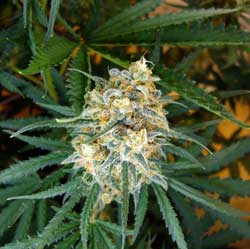
Read the comprehensive harvest tutorial and see more pictures of ready-to-harvest buds.
And Most Importantly…
1.) Always Be Growing!
If you don’t pause between harvests, your coffers will soon be teeming with buds of different strains. Some growers even create two grow spaces for a perpetual harvest. You’ll soon have to figure out what to do with it all.
Never stop growing, and buds will be overflowing!
Along the same line of thought, never stop learning. Surprising discoveries arise every day, which means there is always more to learn about growing and increasing yields!
If you ever have questions about growing weed, make sure to use the search bar as we’ve covered hundreds of topics on GrowWeedEasy.com. Also, sign up for our email newsletter for weekly grow tips delivered to your inbox on Sundays, and join our grow forum for growing help by actual marijuana growers!
BONUS: Now that you have tons of weed, what should you do with it?
Edibles
- Decarboxylation: How to Decarb Your Weed (crucial step for just about every edible recipe)
- Best Weed Butter Recipe
- Canna Caps
- How to Make Cannabis Tinctures
- How to Make Hash Oil (aka Cannabis Extract Oil or RSO)
- Rick Simpson Oil (RSO) – Alternate
Extracts (No Solvents Used in Any Recipe)
- Solventless Extraction Showdown – Bubble Hash vs. Dry-Ice Hash!
- Dry Ice Hash (Made with Dry Ice)
- How to Make Bubble Hash (Made with Ice Water)
- How To Make Your Own Homemade Rosin (dabs)

